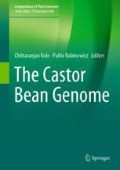Abstract
Castor bean (Ricinus communis L.) is an important industrial oilseed crop with diverse sex patterns. Understanding the genetics and genomics of castor bean sexual reproduction is valuable for both its breeding and sex-determination researches. Here, we described the biology of flowering habit, sex forms, and sex variations in castor bean. Castor plant grows to raceme–cyme inflorescence and has the potential to be an ever-flowering perennial, it is normally monoecious raceme, but other inflorescence patterns such as pistillate, male, and intersperse also can be observed. A simplified overview on wide variation of sex tendency and variegation phenomenon in sex expression was given, and the factors affected sex expression were also summarized. Moreover, sex inheritance was also generalized, and the genes underlying or involved in the monocism, female, interspersed staminate flowers, and terminal hermaphroditism were mentioned. We reviewed the genetic variation of the replication for pistillate plant by the combination of tissue culture, molecular markers, and conventional breeding. It was showed that pistillate somaclones with high percentage of pistillate plants were obtained, and allelic differences were discovered among individuals of somaclonal populations with instable sex expression. Some genes associated with sex expression and reproduction, hormone response, transcription regulation and signal transduction, have also been identified by digital gene expression (DGE) analysis. This overview provided some information and valuable hints for insights into the molecular mechanism of sex determination.
Access this chapter
Tax calculation will be finalised at checkout
Purchases are for personal use only
References
Anjani K (2012) Castor genetic resources: a primary gene pool for exploitation. Indust Crop Prod 35:1–14
Chauhan SVS, Saxena BK, Kinoshita T (1987) Effect of daminozide (B9) on sex-expression and seed setting in castor bean, Ricinus communis L. Jpn J Breed 37:262–266
Dellaporta SL, Calderon-Urrea A (1993) Sex determination in flowering plants. Plant Cell 5:1241–1251
George WL, Shifriss O (1967) Interspersed sexuality in Ricinus. Genetics 57:347–356
Heslop-Harrison J (1957) The experimental modification of sex expression in flowering plants. Biol Rev 32:38–90
Jacob KM (1963) A trisomic male castor bean plant. J Hered 54:292–296
Jacob KM, Atsmon D (1965) Sex inheritance in Ricinus communis L.: evidence for a genetic change during the ontogeny of female sex reversals. Genetica 36:253–259
Joshi WV (1926) Some variations in the inflorescence of the castor plant. Poona Agri Coll Magaz 18:26–29
Katayama Y (1948) The progeny of female individuals in castor beans. Jpn J Genet 23:19 (in Japanese)
Kumar NR, Rao PG (1981) Activity of auxin like substances in relation to feminization of castor bean (Ricinus communis L.) influenced by kinetin and morphactin. Turrialba 31:201–208
Philipos H, Narayanaswamy S (1976) Induced potential for male sex expression in Ricinus communis L. by ethyl hydrogen-1-propylphosphonate. Protoplasma 87:71–77
Rkey VA (1978) M: experimental studies on effects of plant growth regulators on vegetative morphology and floral morphogenesis in Ricinus communis L. Ph.D. dissertation (Agronomy), Kanpur University, India
Roxburgh W (1874) Flora Indica. Thacker, Spink & Co, Calcutta, India
Shifriss O (1956) Sex instability in Ricinus. Genetics 41:265–280
Shifriss O (1960) Conventional and unconventional systems controlling sex variations in Ricinus. J Genet 57:361–388
Shifriss O (1961) Gibberellin as sex regulator in Ricinus communis. Science 133:2061–2062
Tan M, Yan M, Wang L, Yan X (2011) Effect of chemical treatments on sex expression of Ricinus communis. Chin Agri Sci Bull 27:164–169
Tan M, Yan M, Wang L, Yan X, Fu C, Wang L (2013) Replication of pistillate plants of Ricinus communis L. and investigation of the sex stability and genetic variation of the somaclones. Indust Crop Prod 50:50–57
Tan M, Xue J, Wang L, Huang J, Fu C, Yan X (2016) Transcriptomic analysis for different sex types of Ricinus communis L. during development from apical buds to inflorescences by digital gene expression profiling. Front Plant Sci 6:1–16
Trebitsh T, Rudich J, Riov J (1987) Auxin, biosynthesis of ethylene and sex expression in cucumber (Cucumis sativus). Plant Growth Regul 5:105–113
Varkey M, Nigam RK (1982) A gradual reduction of female structures in the pistillate flowers of Ricinus communis L. (castor-bean) with chlorflurenol (morphactin). Biol Plant 24:152–154
Author information
Authors and Affiliations
Corresponding author
Editor information
Editors and Affiliations
Rights and permissions
Copyright information
© 2018 Springer Nature Switzerland AG
About this chapter
Cite this chapter
Tan, M., Wang, L., Yan, X. (2018). Sexual Reproduction in Castor Bean. In: Kole, C., Rabinowicz, P. (eds) The Castor Bean Genome. Compendium of Plant Genomes. Springer, Cham. https://doi.org/10.1007/978-3-319-97280-0_9
Download citation
DOI: https://doi.org/10.1007/978-3-319-97280-0_9
Published:
Publisher Name: Springer, Cham
Print ISBN: 978-3-319-97279-4
Online ISBN: 978-3-319-97280-0
eBook Packages: Biomedical and Life SciencesBiomedical and Life Sciences (R0)

